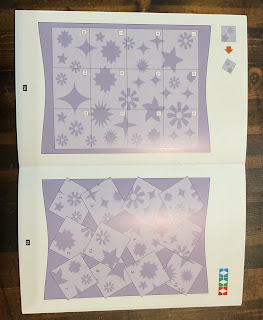We did BambinoLUK Set A and B for preschool. This year we got miniLUK Set A and Set B. What I liked about these a couple years ago is that there was a huge variety of critical thinking work. The same is true about these miniLUK sets. Each booklet has abut 24 to 26 problems to solve. What I like to do with miniLUK is organize the books based on difficulty. The books tell you at the top what level of difficulty each one is. I start with the booklets that are the lowest difficulty and end with the harder ones.
The bases of this activity is to match the pictures together. Each book starts out easy and gets progressively harder. Some of the problems are just matching the same pictures. Others are a bit more challenging like you see part and then have to find what full picture it goes, too. There are math booklets in which your child will need to know how to do basic math like counting, addition and subtraction. Your child will get to match silhouettes, mixed up pictures and more. They will use a lot od skills through all the different books. There is critical thinking, basic math and geometry, visual perception and concentration.
With these miniLUK sets there are also 6 books that are “Advanced Level”. In these booklets you do not set the game pieces on the book but rather next to it. The left pages are the questions and the right pages will be the answers. There are mazes and your child will have to complete the maze in order to fins the correct answer. Then there are some questions where you have to figure out what the picture is behind the top object. Some problems in these books focus on directions as well. If your child is not yet confident in this then it is a great way to learn them. When our daughter was learning directional words I did both visual and then in a physical way. We would stand up and act out each direction together. It was a very affective way to teach her while also getting in some exercise.
I know a lot of the parents and homeschoolers have a set budget on how much they spend each school year. With that in mind I would recommend miniLUK over other critical thinking games and activities. The wide variety is amazing. Progressively getting more difficult is a smooth transition so the child will not be bombarded with going from easy to oh my goodness this is hard. Another huge plus to these activities is that your child can do them completely on their own. So if you need to get something done the child can learn a bunch on their own. We have gotten both think years and the preschool year from Timberdoodle where we get all of our homeschool curriculum. They have so many great products for grades from toddler through 12th grade.






Comments
Post a Comment